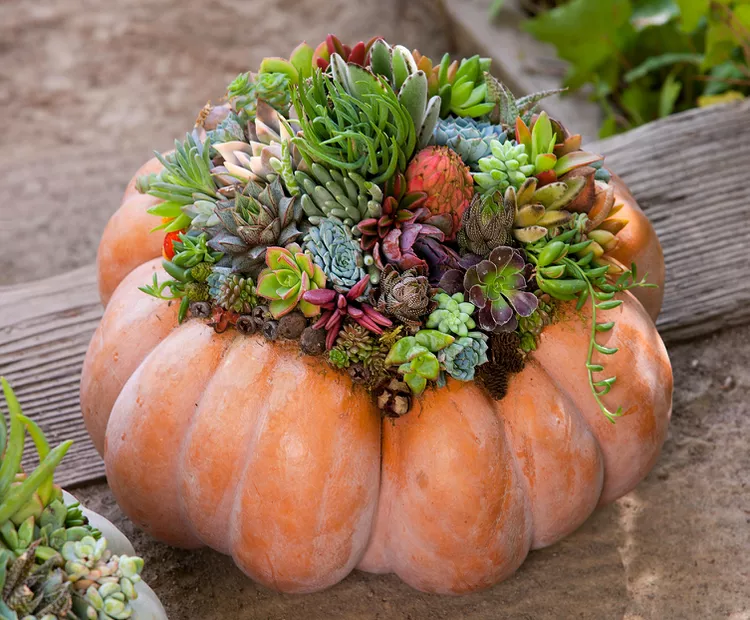Take advantage of the abundance of pumpkins this fall to create a fabulous living arrangement of colorful succulents. This project will come together in minutes with a bit of moss and glue. Your pumpkin succulent centerpiece will look just as gorgeous sitting on a porch as it will on a dining room table, but if you use it outdoors, be sure to bring it inside whenever temperatures dip below freezing. Some succulents can tolerate colder temperatures, but this fresh fall centerpiece will do better inside when the weather turns chilly.
Here's how to do this simple project and care for it, so it lasts all season (and even longer).
What You Need
- Pumpkin (a pumpkin that's flatter on top works best)
- Spray adhesive
- Sphagnum moss
- Clear gel crafts glue or hot-glue gun and glue sticks
- Variety of small succulents, especially orange, yellow, or red types
How to Do It
Step 1: Coat with Adhesive
Start by applying a spray adhesive to the top of your pumpkin. To help the moss stick, choose a pumpkin with a flat top; Cinderella pumpkins have a great shape for this project.
Step 2: Add Sphagnum Moss
Before the spray adhesive dries (you want it tacky), press dry moss onto the top of the pumpkin, creating a layer ½ to 1 inch thick.
Step 3: Attach Succulents
:strip_icc():focal(571x656:573x658):format(webp)/gluing-succulents-to-moss-on-pumpkin-48061642-1af47832e5e8491a92e830492510945c.jpg)
:strip_icc():focal(633x657:635x659):format(webp)/using-glue-gun-to-add-succulents-to-pumpkin-b4ab837f-ed7ec502b759443b961bbdb0204df80a.jpg)
Working from the center outward, group the three tallest succulents slightly to one side of center. Use a clear crafts gel type of glue or a hot glue gun to adhere succulent cuttings to the moss. Keep adding more succulents around this first group, packing them tightly together. If you're not sure what kinds of succulents to use, start with hens-and-chicks and sedums, both of which come in varieties that stay small and offer interesting colors and textures.
Step 4: Finish Arrangement
Aim for a mounded succulent pumpkin centerpiece arrangement, with taller succulents closer to the center of the pumpkin and shorter ones angled outward. Burro's tail succulents would make a great choice for the outer edges because their trailing tendrils look best draped over the edge of a pot (or, in this case, a pumpkin).
Pumpkin Succulent Centerpiece Care
For a long-lasting centerpiece, protect your succulent-topped pumpkin from harsh sun, excessive heat, freezing temperatures, and rain. Good air circulation is also essential. You can prevent the pumpkin from rotting prematurely by placing it on top of a ¼-inch-thick piece of cardboard (this will help prevent moisture from collecting, and it works for carved jack-o'-lanterns, too!). Spritz the plants once a week to moisten the moss and hydrate any new little roots that might have formed. Avoid letting water pool around the pumpkin's stem.
Treat the centerpiece just like any houseplant. Give it bright, indirect light by setting it near a window indoors or on a sheltered deck or balcony. Keep it away from heaters and vents that can cause major temperature shifts. To transition the succulents to a more permanent home once the pumpkin is past its prime, slice off the very top of the pumpkin and nestle the arrangement atop potting soil in a container. The pumpkin flesh will eventually rot away, and the succulents will root into the soil.
If you love the look of succulent pumpkins, you don't have to stop with pumpkins. Try topping other winter squash varieties with succulents and creating a grouping to display on your front porch, dining table, or mantel. To complement an orange pumpkin, consider adding dark green, gray-green, white, striped, mottled squashes, and gourds to the mix.




















